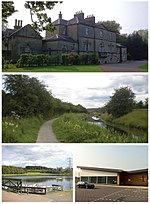River Carron, Forth
GrangemouthLarbertRivers of Falkirk (council area)Rivers of Stirling (council area)Stenhousemuir

The Carron (Gaelic: Carrann) is a river in central Scotland, rising in the Campsie Fells and flowing along Strathcarron into the Firth of Forth. It has given its name to several locations in Stirlingshire, as well as a type of cannon, a line of bathtubs, two warships, and an island in the Southern Hemisphere.
Excerpt from the Wikipedia article River Carron, Forth (License: CC BY-SA 3.0, Authors, Images).River Carron, Forth
Central Dock Road,
Geographical coordinates (GPS) Address Nearby Places Show on map
Geographical coordinates (GPS)
| Latitude | Longitude |
|---|---|
| N 56.0261 ° | E -3.7166 ° |
Address
Central Dock Road
Central Dock Road
FK3 8UB , Kersiebank
Scotland, United Kingdom
Open on Google Maps










